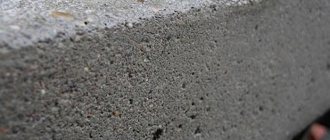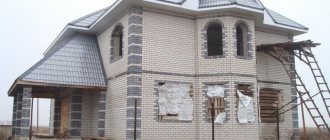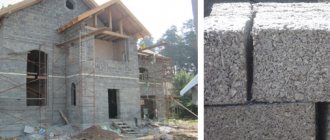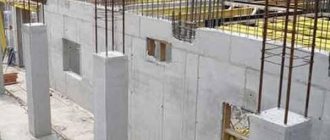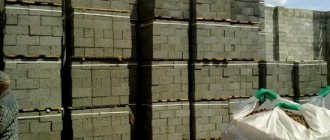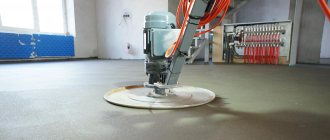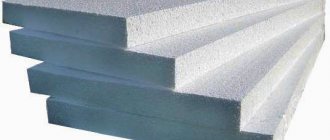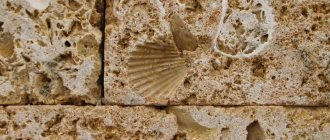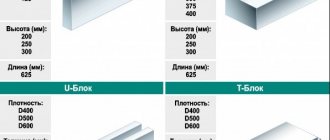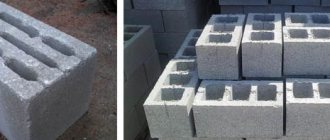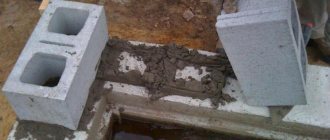What is self-compacting concrete?
Self-compacting concrete (SCC, in English literature - SCC) is a highly mobile, non-separating concrete that spreads over the pit, fills the formwork and envelops the reinforcement without any mechanical effort. The flow of SCC is measured in terms of flow using the ASTM C 143 test. The flow (workability) of SCC typically ranges from 45.5 to 81 cm depending on project requirements. Viscosity, which is visually defined as the rate of spreading of the mixture, is an important characteristic of plastic SCC, which can be controlled at the mixing stage in order to suit the specific type of object being built.
What is SUB
Self-compacting concrete is a type of building material that can compact under the weight of its own weight and evenly fill the formwork. It is most often used when working with precast concrete, in the construction of durable seamless floors and in shotcrete.
In terms of its composition, this material is a water-sand mixture with various ingredients designed to give concrete characteristic beneficial qualities, including:
- strength;
- accelerated hardening;
- long service life.
WHY is SUB used?
Some advantages of using SMS:
- Can be placed faster, without mechanical vibration and with less leveling, which translates into savings in pouring costs.
- Improved and more uniform architectural surface with little or no remediation work.
- Easily fill obstructed and hard-to-reach areas. The ability to create structural and architectural forms and surfaces not available with conventional concrete.
- Increased envelopment of reinforcement and improved strength of interaction with it.
- Increased pumping ability.
- Increased uniformity of poured concrete due to reduced manual leveling work.
- Reduced labor costs.
- Acceleration of construction and, as a result, cost savings.
- A shorter mixer turnaround time allows the plant to more efficiently maintain the facility.
- Reduced or eliminated vibration to avoid or reduce noise levels, resulting in longer workdays in urban environments.
- Minimize the movement of mixers and pumps around the construction site.
- Increased safety on the construction site due to the elimination of compaction.
What is added to it
To give concrete the desired properties while mixing it, professionals recommend using some additives:
- sand and small gravel. But it should be remembered that along with an increase in strength, the material becomes more viscous;
- Micro- and ultrafine fillers will help make the SCC noticeably stronger, and also prevent corrosion of the reinforcement and the formation of microcracks in the material. They must be measured strictly according to the recipe and in accordance with the volume of SUB in each specific situation.
HOW IS SUB MADE?
Self-compacting concrete in its plastic state has two important characteristics: flowability and persistence. High flowability is usually achieved by adding water replacement additives (HRWRs) and reducing the volume of water in the mixture. Storability, or resistance to separation of a plastic concrete mixture, is achieved by increasing the volume of fine aggregate in the mixture (by increasing the content of the cementing component or using mineral fillers) and by using additives to increase viscosity. Such additives are especially useful when the ratio of aggregates cannot be changed. Proper distribution of aggregates in the mixture allows self-compacting characteristics to be achieved with less binder or additive consumption. Although SCC can be mixed with aggregates up to 38mm, it is easier to make and control with smaller aggregate sizes. Control of wet aggregates is critical to obtaining a quality mix. SCC typically has relatively more (cement) paste, less coarse aggregate, and more fine aggregate than regular mix.
It is important to ensure the spreadability of the mixture when unloading it at the construction site. High temperatures, long delivery times and delays at the construction site can cause reduced flow, negating the benefits of using SCC. Adding water on site does not always restore lost flowability, but can cause problems with the consistency of the mixture (not to mention problems with strength - approx. trans.)
Due to the potential for mixture leakage, it is not recommended to transport high flow SCC in fully loaded mixers. If this must be done, it is better to transport the reduced flow mixture and add water replacement additives (HRWR) directly on the job site. Care must be taken to maintain the shelf life of the mixture and to minimize clogging of the pump boom when pumping and placing in hard-to-reach areas. The formwork must withstand the high pressure of the mixture. In higher elements the SCC can be placed in lifts. Once the concrete is poured, it should not separate or release water.
By analogy with conventional mixtures, special additives can be used for self-compacting concrete to achieve certain characteristics at the design age. If a self-compacting mixture is designed with increased binder or fine aggregate, an increase in shrinkage volume may occur.
Concrete that flows and compacts itself
Using outdated materials and methods for constructing buildings and structures, as well as unqualified personnel, it is impossible to ensure technical progress in construction.
What to do? How can we ensure proper quality of construction in modern conditions? The answer is simple: only through the use of new technologies and modern building materials, as well as through constant quality control of raw materials and materials (primarily the concrete mixture and its components), can high quality construction be ensured in modern conditions. There is an urgent need to catch up, master working with new materials and modern equipment, and pay attention to improving the qualifications of staff, starting with the student audience.
In Russia, almost half of the buildings are built using the monolithic and prefabricated monolithic method. Installation of reinforcement frames and formwork, delivery, laying and compaction of concrete mixture with subsequent maintenance are now the main components of the process of constructing buildings and structures. Is it possible now to simplify and reduce the cost of this process without compromising the quality of construction, for example: by eliminating the process of vibrating the concrete mixture? The answer is simple: you can, through the use of self-compacting concrete , which has been successfully used on construction sites around the world for about 25 years.
Self-compacting concrete is concrete that, without the influence of additional external compacting energy on it, flows independently under the influence of its own mass, is freed from the air contained in it and completely fills the space between the reinforcing bars and the formwork. Self-compacting concrete contains the same residual pore volume as “vibrated” concrete.
History and research of self-compacting concrete
The history of self-compacting concrete began in Japan in 1990. There, Professor Hayima Okamura created and put into practice a new generation of concrete additives, namely highly effective additives for improving flowability based on polyacrylate and polycarboxylate. He managed to create concrete with high plasticity and low water content. In addition to Okamura, Professors K. Maekawa and Katsumasa Ozawa took part in the creation and development of self-compacting concrete.
Thanks to the unique properties and advantages of this concrete, it quickly spread towards Western Europe. Initially, this concrete was used at enterprises that produced ready-made reinforced concrete products. Then self-compacting concrete begins to be actively used as the so-called “transport concrete”, i.e. concrete, which is delivered and laid directly on the construction site.
Further active development and study of the properties of self-compacting concrete took place in Germany. Thus, at the Institute for Building Research in Aachen (Germany) in 2000 and 2001, under the leadership of Professor Wolfgang Brameshuber, after a thorough study of its properties, the first prerequisites were created for the official approval and distribution of this material throughout Europe. Studies carried out in Aachen showed that the compressive strength of self-compacting concrete was generally higher than that of conventional "vibrated" concrete, and the splitting strength, static modulus of elasticity, shrinkage and creep of self-compacting concrete were the same. In addition, this material had excellent waterproofing properties and was thus officially approved and recommended for use in the construction of waterproof structures. The material was named “DyckerhoffLiquidur” and began to actively spread throughout construction sites in Europe due to its unique properties.
The latest step to expand the distribution of self-compacting concrete in Western Europe was the publication in Berlin by the “German Committee for Reinforced Concrete” in November 2003 of the regulatory document “DAfStb-Richtlinie Selbsverdichtender Beton (SVB-Richtlinie)”. This 41 page normative document details the terms and relationships with other European normative documents, as well as methods for diagnosing self-compacting concrete. Thus, after the release of this regulatory document, self-compacting concrete is officially approved and approved for use in Europe, without the need for any additional permits, approvals or approvals.
Since 2003, the German manufacturer of laboratory equipment, the company TESTING Bluhm&Feuerherdt GmbH, began mass-producing and supplying its customers with the necessary laboratory equipment for diagnosing SUB. Methods for testing self-compacting concrete in a construction laboratory in Russian are described in detail in the monograph by the author of this article: “European methods of physical and mechanical testing of concrete,” published in Kharkov in 2010.
Composition of self-compacting concrete
The composition of the mixture components for the preparation of self-compacting concrete is carried out, as a rule, according to the Japanese method developed by Professor Okamura. The concept of this formulation is based on increasing the proportion of fine dust particles. Recipes for self-compacting concrete according to Professor Okamura are based on the following boundary conditions:
- the bulk volume of coarse aggregate should be no more than 50% of the volume of concrete;
- the volume fraction of sand in the solution should be 40%.
When optimizing the composition of self-compacting concrete, the following questions usually arise:
- How to choose the optimal amount of sand?
- Is a large amount of cement really necessary?
- What effect do the different fillers in the mixture (fly ash and ground limestone) have?
- How much coarse aggregate can I use?
The composition and types of self-compacting concrete are constantly evolving. So, for example, in 2003, Germany received permission to use lightweight self-compacting concrete. Despite the low density in the unmixed state, equal to 1.38 kg/dm3, this concrete has excellent mobility and the ability to self-compact. The mechanical properties of this concrete are similar to those of conventional concrete.
Properties of self-compacting concrete
Analysis of the most recent studies carried out in Japan, Germany and Sweden provides insight into the properties of self-compacting concrete. For the most part, they largely coincide with the properties of ordinary concrete. By combining components, self-compacting concrete can be designed as either normal strength concrete or high strength concrete.
Compressive strength
With a similar cement content and water-cement ratio, self-compacting concrete has higher compressive strength due to the denser composition of the mixture.
Tensile strength
With similar compressive strength values, self-compacting concrete has a slightly higher tensile strength compared to conventional concrete.
Concrete/reinforcement connection
Due to the fact that self-compacting concrete has good mobility and cohesion between individual particles, it has good properties of forming a tight connection with reinforcing bars. In this case, the location of the reinforcement (top or bottom row of bars) does not matter.
Elastic modulus
The modulus of elasticity of self-compacting concrete is approximately 15% lower than that of conventional concrete. This is due to the increased content of fine dust particles in the concrete mixture and the reduced content of the coarse aggregate fraction compared to conventional concrete.
Shrinkage
Concrete shrinkage is always related to the amount of cement paste in the concrete. Since the content of cement paste in self-compacting concrete differs slightly from ordinary concrete, both concretes have approximately the same shrinkage.
Surface quality
The surface of self-compacting concrete repeats the surface of the formwork down to the smallest detail. Thus, when using modern types of formwork, you can immediately obtain a perfectly smooth and even surface.
Advantages of self-compacting concrete
The advantages of self-compacting concrete compared to other traditional types of concrete can be divided into groups and presented as follows:
For the customer : higher investment security due to:
- creating building structures that have high strength and in which defects caused by errors in compacting the concrete mixture are excluded,
- reducing construction duration.
For the architect: a wider choice of structural forms and the ability to give the structure a certain desired appearance due to:
- a special smooth and dense outer surface of concrete, which exactly repeats the shape and surface of the formwork,
- formwork of various shapes and structures,
- the ability to create any geometry of the concrete structure.
For the designer : free choice of the geometry of structures, ensuring its long-term operation and simplifying the development of a work project due to:
- simplification of concreting work (no need for compaction),
- the possibility of a denser arrangement of reinforcing bars,
- tight adhesion of reinforcement to concrete and penetration of concrete into the most inaccessible places in the formwork,
- the possibility of supplying concrete directly through the formwork, for example, through a hole in its lower part,
- a simpler and less massive formwork design (due to the absence of concrete vibration, the formwork is not subject to additional dynamic and static loads).
For a construction company performing work on site : safer construction work and reduced personnel costs due to:
- possibility of laying a larger volume of concrete per shift,
- eliminating the need to compact concrete and thereby eliminating errors that could occur during its compaction,
- opportunities for personnel to work in safer conditions during concreting,
- independent spreading of the concrete mixture throughout the entire structure,
- eliminating the possibility of stratification of the concrete mixture,
- absence of noise and vibration that negatively affects both personnel and people living near the construction site.
Cost-effectiveness and prospects for using self-compacting concrete
The cost-effectiveness of self-compacting concrete can be analyzed on the basis of existing European experience in using this type of concrete. For example, in Germany the following data can be found in the literature:
If we compare prices, self-compacting concrete, due to its modified composition and the cost of individual components of the concrete mixture, is more expensive than conventional concrete of a similar type. The price difference is from 13 to 18 Euros per 1 cubic meter. This increase in the cost of concrete is offset by cost savings when laying it and thanks to a whole group of other advantages of this concrete (see the previous section).
An analysis of concreting work in Germany showed that due to the fact that there is no need to compact the concrete mixture on the construction site, cost savings due to the use of self-compacting concrete when concreting individual building structures can range from 3 to 6 Euros per structure. In addition, the need to compact concrete, for example, when concreting columns and supports, necessitates frequent breaks in the supply of concrete mixture, and when using self-compacting concrete, such breaks are eliminated.
Oleg Bolotskikh,
Associate Professor of the Department of Technology of Construction Production and Building Materials of the Kharkov National University of Urban Economy named after. A. N. Beketova, doctor-engineer; e-mail: [email protected]
This material was published in the September issue of the Industry magazine “Construction”. You can read or download the entire magazine here .
HOW to test the SUB?
There are several procedures for testing the ductile properties of SCC. The flow test, using a conventional cone, is the most popular "field" test recorded by ASTM (American Society for Testing and Materials). The cone is filled with concrete without compaction, raised, and the spread is measured. The spread can range from 45 to 81 cm. Delamination resistance can be tested using the Visual Stability Index (VSI). This measurement is taken at the base whether there is water on the top layer or crowding in the center. Index values range from 0 for highly persistent to 3 for unacceptable persistence.
The viscosity of a mixture can be measured by flow testing with a cone. To do this, you need to measure the time it takes for the mixture to spread 50 cm from the moment the cone is lifted. This is called the T50 measurement and usually has a value of 2 to 10 seconds (although it is not clear what the value is for a self-compacting mixture with a completely acceptable spread value of 45 to 50 cm - approx. transl.). A higher T50 value means a more viscous mixture, more suitable for heavily reinforced objects and deep excavations. Smaller T50 values are suitable for cases where the mixture needs to spread over a long distance horizontally without obstacles.
Preliminary mixture evaluation uses the U-box and L-box tests, where concrete is poured into one part of the box, then the baffle is opened and the ability of the concrete to fill the second part of the box containing the reinforcement is measured. A variation of the cone test is the J-ring, where a reinforced structure is placed around the cone and the ability of the SCC to spread without delamination is measured as the cone is lifted. All of these tests measure the ability of the SCC to overcome dense reinforcement. Another standard test is the column test, which measures the coarse aggregate content at different heights of a cast column as an indicator of persistence (resistance to delamination).
HOW to order and clarify the characteristics of the SUB?
When ordering and/or specifying SCC characteristics, the final application of the concrete should be taken into account. Concrete manufacturers usually have developed proportions depending on the application. The required flowability is based on the type of structure, pouring method, complexity of the formwork configuration and reinforcement. ACI 237 is finalizing a document that will provide recommendations for spreading mixtures depending on the end application. This will make it possible to achieve self-compaction easily, with the required stability of the mixture and at a minimum cost. The requirements for hardened concrete should be drawn up by a professional based on the load requirements of the structure. In most cases, the strength requirements are the same as those for conventional concrete. Depending on the requirements for each specific project, specific requirements for SMS can only be put forward after the requirements for concrete in a plastic and hardened state are clearly defined.
Where can it be used
Of course, sometimes self-compacting mixtures can be used to fill various types of structures and in private housing construction. But today such concrete is used in most cases by construction organizations.
This material is still quite new for Russia. At the moment, no domestic classification of such a product has even been developed. When using self-compacting concrete, builders in the Russian Federation are guided by European standards. However, some documents regulating the use of this material and GOSTs in relation to it have already been created in our country today.
This applies, for example, to the application of self-compacting concrete. According to SNiP standards, in industrial construction such mixtures are allowed and recommended for use:
- in the production of prefabricated reinforced concrete structures;
- during the construction of hydraulic structures;
- when pouring structures whose strength is subject to special requirements;
- for pouring objects of complex architectural shape;
- in the production of Lego bricks;
- for the construction of structures with small thickness (fences, walls, etc.).
Also, such mixtures are very often used for pouring durable seamless floors in the event that they will subsequently be subjected to serious loads (in workshops with heavy machines and equipment, in garages of special equipment, etc.).
Very often, self-compacting concrete is used in restoration work. It is used in this case, for example, when shotcrete.
View gallery
